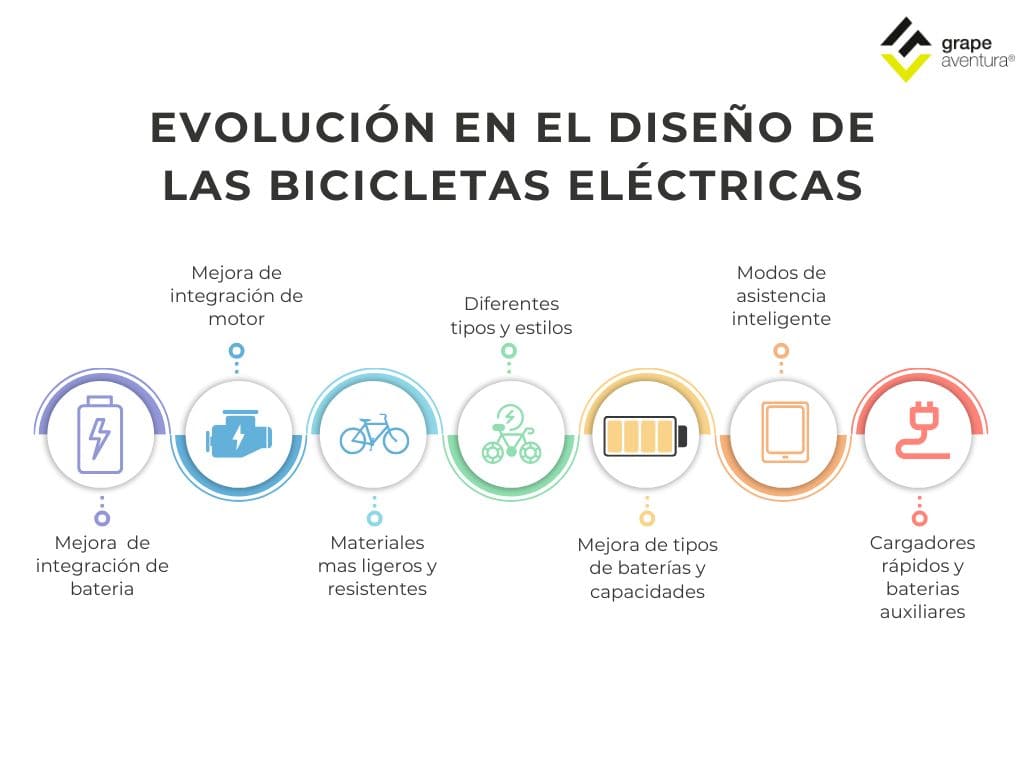Electric bicycles or e-bikes have gained popularity in recent years as an alternative for mobility in the cities, but also to be able to perform cyclotourism or mountain routes.
Their design and performance have evolved greatly in recent years, allowing non-professional cyclists to ride long distances and climb steep terrain without excessive physical exertion.
Therefore, in this article we will explain the parts of an electric bicycle necessary to obtain these advantages, as well as its autonomy. We will also tell you why the evolution of design in recent years has been so important and striking and what is the future of this type of vehicle.
Parts of an electric bicycle
In order to understand how an e-bike works and its capacity to help us when pedaling, it is important to know its main components. Some of these components are common to any bicycle and others are specific to electric bicycles. Below, we explain the components that are only present in electric bicycles and not in conventional bicycles.
Engine
The motor on an electric bicycle is one of the main components, because it is responsible for creating the power to assist pedaling. But something you may not know is that there are two types of motors depending on their location on the bike.
It can be located on the front or rear wheel. This type of motor is more common in urban e-bikes. They are simple motors and, therefore, are usually less expensive.
The motor can also be located in the center of the bike, near the pedals. This is the most popular type of motor on high-end e-bikes. As an improvement over those on the wheels, it allows for balanced weight distribution and better efficiency on uneven terrain.
Another variation in motors is power. In Europe, regulations limit the power of e-bikes to 250 watts, so you won't find e-bikes with higher, but lower, power.
Battery
The battery is another of the most important components of an electric bike, since it is the source of energy for the motor. Currently, the most commonly used batteries are lithium for their lightness, durability and storage capacity.
There are also different types of batteries in bicycles. One of the variations is the capacity of the battery, which determines the autonomy of the bicycle.
A battery of between 400 and 600 Wh is usually sufficient for a range of 50 to 100 kilometers, depending on the level of assistance required and the terrain conditions.
Another difference is the location of the battery. Some batteries are integrated into the bike frame and others are mounted on the bottom bar.
Pedaling sensor
This sensor is another of the main components of an electric bicycle, although much less known than the battery or the motor. This sensor detects the cadence or force with which the rider pedals and sends this information to the motor to adjust the power level in real time.
There are several types of sensors, depending on whether they only measure whether the rider is pedaling (cadence sensor), or whether they measure torque (the force the rider puts on the pedals).
Controller or control unit
This component is essential, as it regulates the amount of energy the battery sends to the motor based on the information received from the pedaling sensor. This device is key to achieving a smooth transition between assistance levels and optimizing the e-bike's energy efficiency.
Control panel or display
It is located on the handlebars. Important information such as battery level, speed, distance traveled and selected assistance level is displayed to the rider.
Charger
Since it has a battery, it is necessary to have a charger. Most e-bike batteries take between 3 and 6 hours to fully charge, depending on the capacity of the battery and the type of charger.
Having seen all these parts that are only present in electric bicycles, let's talk about the evolution of the design they have had in recent years.

Evolution in E-Bike design
Since the first electric bicycle was manufactured in France in 1895 with an electric motor mounted on the rear wheel of a bicycle, there have been numerous design and component changes. For example, that first bicycle had a 100 amp DC motor and a non-rechargeable lead-acid battery. Today, motors up to 250W and lithium batteries with a capacity of between 400 and 750 Wh are used. But in addition to these changes, there have been many other changes such as the following:
Improved component integration
The first e-bikes looked heavy and unaesthetic. They had the battery and motor protruding and adding a lot of weight to the frame.
However, today's manufacturers have integrated the battery and motor in such a way that they increasingly resemble a conventional bicycle. Much lighter and more aerodynamic.
Use of lighter and stronger materials
As we have said, there has been a great development of materials. Currently, materials such as aluminum and carbon fiber are used. Thanks to these materials, the frames are more resistant, lighter (thus improving handling, transport and autonomy), more durable and better able to withstand impacts.
Customized style and options for everyone
Today, there are e-bikes of all types and styles. There are urban models and full suspension mountain bikes. This allows users of all ages to choose an e-bike that suits their style and needs.
One of the points that has had the greatest improvement is the autonomy in electric bicycles, so here we explain the evolution of the autonomy and what is the current autonomy.
Evolution in the autonomy of electric bicycles and what is the current range of electric bicycles
As we have said, thanks to technological advances, the autonomy or distance that an e-bike can travel on a full battery charge is one of the factors that has undergone significant evolution in recent years. This has been thanks to several factors, such as the increase in battery capacity. There are now high-capacity batteries; they have gone from 200 Wh to 600 Wh. Intelligent assistance modes have also appeared: they adjust the motor power according to the terrain and speed. Finally, fast-charging chargers have significantly reduced the waiting time to charge batteries (currently a 50-70% battery can be charged in just one to two hours). In addition, some e-bikes include options for extendable range through additional batteries (a spare battery is carried and changed during the ride).

With all these innovations, we see that electric bikes have changed a lot in recent years. But are there still possible changes?
Future of e-bikes: Innovations in autonomy and design
The future of e-bikes promises even more advances in design and autonomy, with innovations such as solid-state batteries (currently under development), which could offer greater storage capacity, lower weight and longer life. Also regenerative motors: these would allow the battery to be recharged by regenerative braking, thus increasing range. Finally, in the future they will have advanced connectivity that analyzes in real time the energy used and optimizes battery performance through artificial intelligence algorithms.
With everything we have seen, we can see that electric bicycles are one of the preferred options for urban transport as well as for leisure and tourism. For this reason, from Grape Aventura we use them to make cycling routes through La Rioja. Thanks to the normal models and MTBs that we have available, you can enjoy long and hilly routes without great physical preparation or effort. We are waiting for you to discover La Rioja Alta with Haro as departure and return point.









